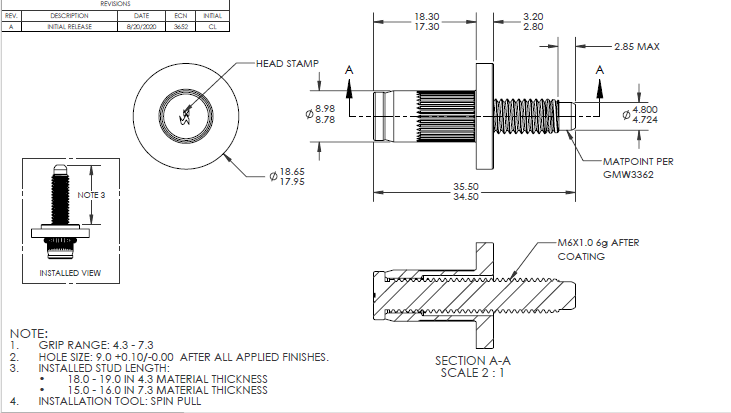FLEX-5: Pull to Pressure or Pull to Stroke?
Leave a CommentWhen installing rivet nuts using a Sherex FLEX-5 hydro-pneumatic tool, you have a decision to make on what kind of tool you want. Do you want a tool that offers a pull to stroke? Or do you want a tool that offers pull to pressure when installing rivet nuts.
Sherex has both FLEX-5P (pull to pressure) and FLEX-5S (pull to stroke) tools available and ready for delivery. But before you place your order, let’s go over the tool and the advantages of pull-to-pressure and pull-to-stroke.
Both Pull-to-Pressure and Pull-to-Stroke tools can install just about any style of rivet nut from sizes #4-40 to 3/18-16 (M3 – M10), and can be used for both low volume and high volume installations, including on an assembly line.
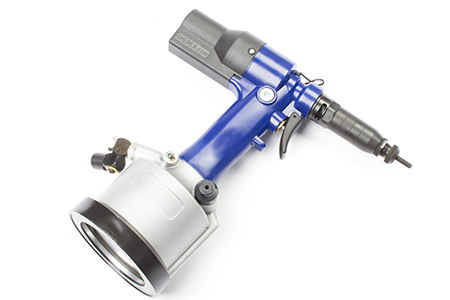
FLEX-5P – Pull to Pressure
The FLEX-5P Pull to Pressure tool is a great, all around tool that can be used to install a variety of different products into different thickness material. With a single stage trigger the tool is easy to use and if you know the proper pressure of the part being installed in your specific material, then you are all set. Use the Sherex Hand Tool Calibration Unit to find out the exact pulling force of your tool and begin your installations.
The FLEX-5P has a pulling force upwards of 5,000 lbs.
FLEX-5S Pull to Stroke
The Sherex FLEX-5S, Pull to Stroke rivet nut tool gives a precise install to an exact material thickness. It can install rivet nuts at a set length and is better suited when the installation has limited backside clearance. The tool offers 7mm of available stroke.
So if you’re installing a very high volume of rivet nuts into the same material thickness, the perfection of the pull-to-stroke tool may be ideal over a pull-to-pressure tool.
Pull to stroke tool is also best utilized when installing into soft or brittle materials.
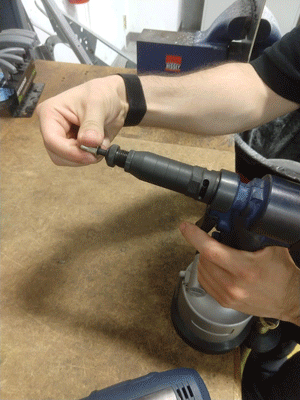
Conclusion
In terms of performance, both tools are extremely durable and can install the same rivet nuts. But the biggest question to answer when deciding between the FLEX-5P or FLEX-5S, do you need the flexibility in installing rivet nuts by pressure, or will this tool be used for a specific material thickness and installed length for a project’s needs?
If you need help on deciding on what tool to purchase, contact us and a member of our engineering team will point you in the right direction.
What are Rivet Nut Studs?
Leave a CommentAfter reading Why Rivet Nuts?, you may come away with, well that’s good, but what’s a rivet nut stud?
Rivet nut studs are simply rivet nuts with an already outward protruding stud installed in the rivet nut. Instead of threading the bolt into the rivet nut, you thread your attachment on to the bolt and you would attach a nut to tighten down the attachment.
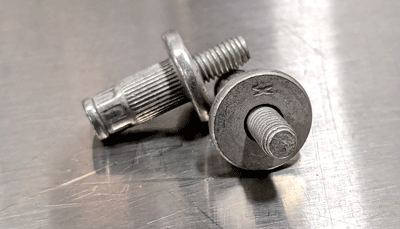
Sherex Rivet Nut Studs
They work the same way as a blind rivet nut, are installed in a similar way, and already have the stud installed. This saves installers the step of putting in the through bolt. Also, when putting an assembly together, it can be beneficial to have something that gets hung on the stud before getting tightened down. This gives the operator something to take the weight off the component before installing the nut over the stud.
Like most blind rivet nuts, rivet nut studs are great replacements for weld nuts when you need a blindly installed, outward-protruding stud for your joint. They are also only needed to be installed in one side of the work piece, where access to the backside is not possible.
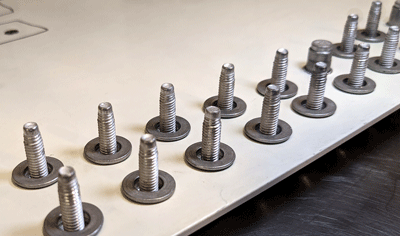
Rivet nut studs can come in a variety of sizes and shapes. Round body, hex body, wedge head, knurls – anything a typical rivet nut can be made into and rivet nut stud can. Rivet nut studs are very customizable. Another thing to consider is the stud. How much thread or stud length will you need for the application? Rivet nut studs can be made to a specific length for the application.
The performance of rivet nut studs vs. a typical rivet nut is very similar, although harder material like steel might yield better performance results than softer material. In general, the performance of spin-out or pull-through of a rivet nut stud compared to a typical rivet nut is negligible if all things are equal.
Rivet Nut Stud Application Use
There are a number of different applications a rivet nut could be used for:
- Wire harnessing on a Truck Frame
- Any applications where a rivet nut stud will be used as a hanging point on a centering pin
- Locating or guide pin
- Can replace any weld nut application
- Automotive applications, like spoiler installations, installed into castings, roof racks
- Agriculture applications
- Heavy Truck applications
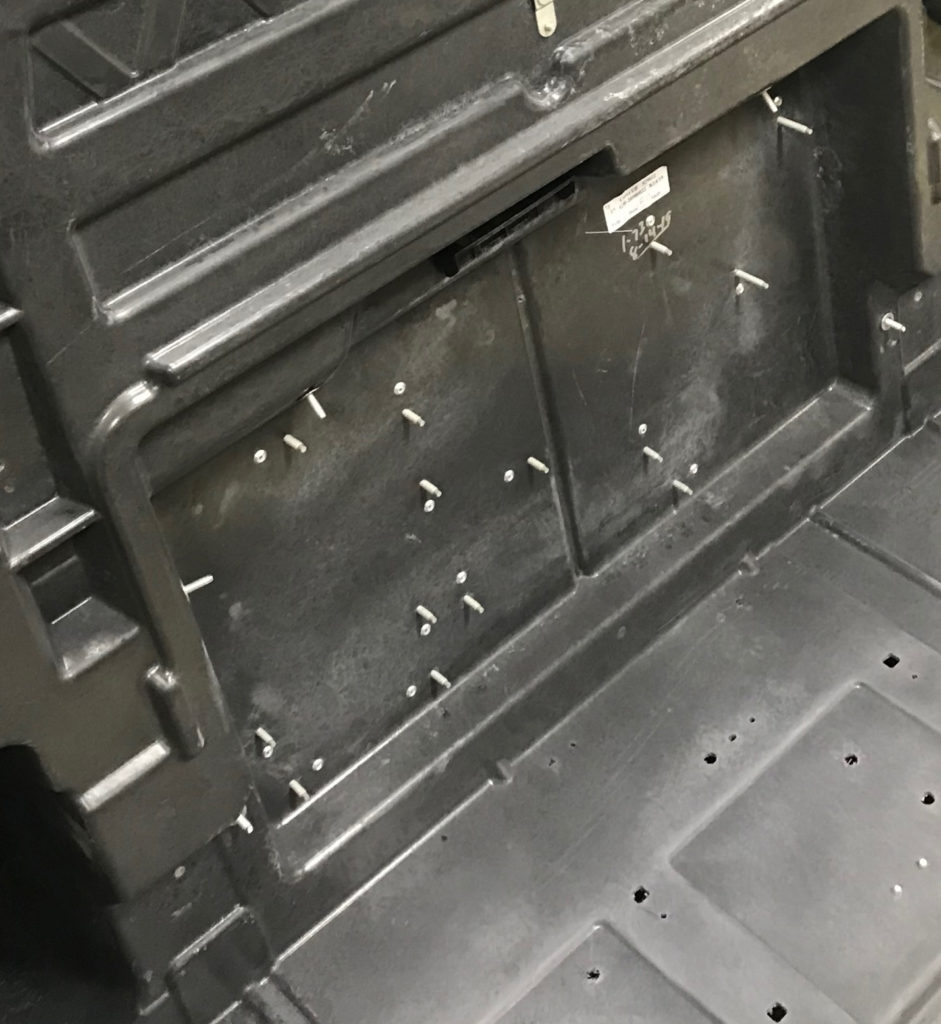
Rivet Nut Stud Application on Automotive Casting
Rivet nut studs are typically more expensive than a rivet nuts, but remember, the cost of the stud or bolt is also considered into the higher price. When you factor a rivet nut plus a bolt/stud, it’s roughly the same amount per part ($rivet nut stud = $rivet nut + $stud/bolt). Another thing to consider is the potential in time saving, or even ease of assembly for assemblers and installers. Rivet nut studs could very well be a more productive fastener depending on the application, saving money by being able to assemble more products faster.
Rivet nut studs are a great option and should be considered any time you have an application that needs a rivet nut and weigh out the options if it makes sense to use one. If you’d like to speak to one of Sherex’s application engineers to see if an application is worthy of a rivet nut stud, contact us!
Sherex Warehouse Manager Training for World Record Hockey Game
Leave a CommentIt’s like training for a marathon, on ice skates.
That’s what our warehouse manager Justen Ehrig will be doing over the next seven months. Justen is a competitor in the 11 Day Power Play, an 11-day long hockey game that takes place in November to benefit local charities and cancer research in the Buffalo-area. This year, the event will be trying to break the Guinness World Record for the longest hockey game, which currently sits at 252-hours long.

This will be Justen’s second time trying to break the World’s Longest Hockey game.
Justen will be playing approximately 100 hours of hockey in just 11 days, putting in around 20, 4-hour shifts as goalie and skater. At the same time he’s training for this event, Justen will be hoping to raise $20,000 to help the event reach its goal of $1,000,000. As of April 1, he’s already over $9,000.
Justen has played in this event since the event began in 2017, playing as an ode to his mother. Justen’s mother, Sherrie, was diagnosed with stage 4 breast cancer in 2016 and passed away in December 2017 after Justen played in the inaugural event. Sherrie watched Justen play all 11-days when he participated in the event in 2017.
“I was driving to work one day and heard about it on the radio promoting the event, and I signed up immediately,” Justen said. “That was my way of wanting to fight for her and everybody else in our community.”
Training for this game is intense. Justen said his team is currently being trained by Excelsior Orthopedics, whose certified Athletic Trainers often train professional and Olympic athletes.
With the event seven months away, overnight skates, running, dieting, and even sleep training has already begun. After all, Justen will be sleeping, eating, and spending all 11 days of this event at the hockey rink. There’s no going home to refresh. Over 250 straight hours either at the hockey rink or in a locker room acting as a makeshift dormitory, waiting until your shift gets called every eight hours or so.
“You play hockey more than you sleep,” Justen said. “It’s quite the physical gauntlet, but it is really just as much a mental battle as well.”
Justen has raised upwards of $40,000 since 2017 while participating in this event. To donate to Justen’s fundraising efforts, click here.
More to come as we periodically check in on Justen during his journey to participate in the 11-Day Power Play!






